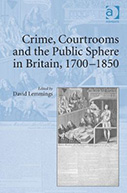Crime, Courtrooms and the Public Sphere in Britain, 1700-1850

Editor: David Lemmings
Publisher: Farnham, Surrey, UK; Burlington, VT: Ashgate Publishing Limited, 2012, 234 p.
Reviewer: Carolyn B. Ramsey | January 2014
This anthology edited by David Lemmings considers the evolving relationship between the criminal courts and the lay public in Britain over a long century between 1700 and 1850. While John Langbein, John Beattie, and others have tracked the rise of evidence rules and lawyers in the criminal trial in the eighteenth century, the new generation of scholars who contributed to this book take their research a step further by exploring the impact of increased publicity about criminal justice on readers’ attitudes toward the legitimacy of the law. A key question is whether “the theatre and counter-theatre that had been a feature of courtroom proceedings before the mid-eighteenth century were not stifled by ‘lawyerisation,’ but rather partly relocated to the ‘public sphere’ of the press” and even popular fiction in the late 1700s and early 1800s (p. 4). The book consists of eight chapters by historians of British criminal justice, tied together by Lemmings’ masterful discussion of common themes in a lengthy introduction. Most of the contributions relate to the amount and quality of press coverage of criminal cases in different types of publications, aimed at various readerships.
The book’s most significant achievement is its insight that the interaction of an expanding print culture with newly transformed criminal trial procedures potentially had ramifications for the growth of a public sphere in which “widespread discussion and disputation about public affairs could contribute positively to good governance” (p. 17). The authors offer a socio-cultural history, rather than being concerned primarily with changing legal rules or with statistics about crime, conviction, and punishment (though several chapters include valuable empirical data). Ultimately, the book makes the case that print culture—whether in the form of published case reports, newspaper articles, broadsides, or crime fiction—served more serious ends than simply entertainment, despite its largely commercial nature. However, commendably, the authors are careful not to overstate their claims about the role of the press and popular fiction in stimulating public participation and critique. Indeed, several of the chapters depict substantial government control over criminal trial reporting to ensure that the stories that the public consumed centered on the immorality of the accused and the severity of legal outcomes. The prosecution bias of many types of reporting is evident.
To give potential readers a sense of the scope and value of the anthology, a chapter-by-chapter discussion of the authors’ individual contributions may prove helpful:
Esther Snell’s analysis of 256 rape trial narratives published in the Proceedings of the Old Bailey criminal court in London between January 1700 and December 1800 highlights “the struggle between publicity and privacy” (p. 24). The prompt complaint rule and the need to show that the accused had actually penetrated the victim and ejaculated in her body required prosecutors to delve into the intimate details of the alleged rape. Victims’ shame and modesty about describing their assaults led to a high rate of acquittal. Snell also demonstrates that the Proceedings replicated tensions between demanding evidentiary standards and “popular ideas of acceptable discourse concerning sexual behavior” (p. 25), so that while some readers may have enjoyed the salacious narratives and even read them for sexual stimulation, the Proceedings sometimes omitted “details considered ‘too indelicate for publication’” (p. 36).
A weakness of Snell’s chapter lies in its failure to establish causal connections between the Proceedings and the conduct of either prosecutors or rape victims. She notes that the Proceedings often attributed acquittals in rape cases “to the failure of prosecutors to provide the necessary depth of information” (p. 34), and she contends that such narratives shaped public attitudes about what was needed to prove that a man had committed a sexual assault. But it is unclear that the published accounts of rape trials, as opposed to the stringent, male-biased evidentiary standards actually imposed by the court, affected prosecutorial strategies. The relationship between rape victims’ shame and the reporting of rape trials in the Proceedings is also opaque. Did rape victims know that the details of their sexual histories and injuries would be published? Did media exposure discourage them from reporting their victimization or cooperating with prosecutors at trial by testifying about the intimate details of sexual assaults? Despite these limitations, Snell vividly captures the dilemma faced by victims, prosecutors, and even reporters in rape cases and convincingly suggests that explicit accounts of rape trials in the Proceedings furtherentrenched the severe and arguably misogynistic standards that governed such trials in the criminal courts.
In the next chapter of the anthology, Andrea McKenzie describes four editions of another type of report on Old Bailey cases between 1718 and 1764 – the Select Trials, which were published with an educated lay readership, as well as legal professionals, in mind. Her analysis tracks shifts from a criminal courtroom that privileged assumptions about the character of the accused to one that focused on the rational weighing of character evidence against other types of evidence, and finally, to one where evidence of the defendant’s good character was largely unavailing. As compared to the more comprehensive Old Bailey Proceedings, the Select Trials focused disproportionately on capital crimes likely to lead to execution. McKenzie finds subtle differences in emphasis between the first three editions of the Select Trials but highlights a marked change in 1764. Whereas earlier editions commented on “the mildness with which the ‘Bloody Code’ was administered” (p. 54), the 1764 edition emphasized the inexorability of public justice and intolerance for capital crimes, especially forgery. With its heightened bias in favor of the prosecution, the 1764 Select Trials offered sympathetic details of each defendant’s character, not as a mitigating factor, but to send an admonitory message that, despite the good character of a defendant, a stern judgment must still be imposed under law.
Robert Shoemaker’s contribution to the book, like Esther Snell’s, uses the Proceedings of the Old Bailey as its primary source. Whereas Snell looks at the entire eighteenth century, Shoemaker focuses on 1770 to 1800. His primary interest is to document the official position of the City of London on the reporting of Old Bailey trials. The quasi-official Proceedings dramatically expanded public information about such trials at a time when the physical presence of a lay audience had diminished. Thus, the Proceedings’ reports about the role of defense counsel were “a subject of political significance” (p. 90). Shoemaker demonstrates the City’s continued “attempt to limit what the public would be told” (p. 91) about defense arguments and strategies. He charts roughly three periods: the inclusive approach of the early to mid-1780s, when defense tactics and challenges to judicial authority appeared in the reports; a backlash from the late 1780s to 1792, during which the City cracked down on descriptions of acquittals and lawyers’ activities in favor of a “law and order” message; and a return at the end of the eighteenth century to discussion of defense counsel’s participation. The pendulum-like operation of the City’s censorship continued into the nineteenth century, indicating that the government understood the need to control the public face of criminal justice but that its approach to allowing reports on the defense side of criminal trials vacillated, depending on the social and political backdrop.
Simon Devereaux’s interesting chapter departs from the central theme of the book by considering the dramatic role of criminal defense lawyers in the courtroom itself, rather than in published accounts. Devereaux makes some fascinating connections between the barrister’s art of storytelling, the tools used by actors in the theatre, and anxieties about the transition from the unmediated testimony of criminal defendants to the performances of their lawyers.
Because the late Hanoverian and Victorian public associated the barrister’s craft with the actor’s, theatrical defense tactics may have exacerbated fears that the substitution of defense counsel for the defendant’s own speech would obfuscate and distort the truth. Readers who are not experts in eighteenth and early nineteenth century legal history might benefit from more explanation of how defense lawyers used their powers of persuasion to such dramatic effect before they could make arguments to the jury—an activity from which they were banned prior to 1836.
Devereaux’s chapter also could have been better integrated with the contributions of the other authors, who primarily focus on print culture. Yet, despite its somewhat anomalous inclusion in an anthology primarily devoted to media reporting, Devereaux’s piece makes a fascinating read, and his suggestions for further research raise important questions, such as whether the decline in emphasis on the facial features and expressions of defendants may have signaled a turn from the visual to the verbal that enhanced the role of lawyers and the use of interrogation in criminal cases.
David Lemmings and Anne-Marie Kilday each contribute chapters on Scottish criminal justice and thus lend the anthology a comparative angle. Lemmings describes press coverage of two cases to assess the extent to which newspaper reporting allowed for public commentary on criminal justice and to test whether such commentary legitimized the prosecution’s case or fostered critique. The two case studies he offers—first, the conviction of Captain Thomas Green and his crew in Scotland on charges of piracy, robbery, and murder; and second, the murder trial of an army officer in England—indicate that newspapers often waited until the trial had concluded to offer public comment. Both cases show the potential for press reports to reveal controversy over post-trial decisions about punishment. The English press questioned the verdicts and sentences imposed by a Scottish court in R. v. Green, against a backdrop of Anglo-Scottish tensions. However, both English and Scottish newspapers generally remained deferential to their own judges and criminal procedure; thus, the Scottish press defended the government’s position in the Green case.
Anne-Marie Kilday’s chapter on Scottish criminal justice notes high conviction rates and the imposition of severe, sensational punishments, especially on women, in comparison to England’s more laxly enforced Bloody Code. Before the 1780s, Scottish newspaper coverage of criminal trials was scanty; toward the end of the eighteenth century, a sea change in reporting led to increased coverage of criminal cases that primarily reproduced court transcripts and thus drove home a message of condemnation toward the defendant. Popular pamphlets used the purported confessions of the criminals themselves to underscore the immorality of their acts, with the only mild dissent coming from the writings of medical men who took a sympathetic view of infanticide defendants. The press thus functioned chiefly as “a regulatory tool” to remind the public that Scotland had a “problem with crime,” even though its crime rates were actually lower than those in many European countries, and to put would-be criminals on notice of the harsh fate they could expect (p. 166).
Whereas most contributions to the book depict a print culture that largely supported the legitimacy of government and the soundness of the prosecution’s case, Allyson N. May offers examples of fictional works that presented highly critical portraits of magistrates and lawyers and promoted criminal law reform. Analyzing stories by Edward Bulwer-Lytton, William Harrison Ainsworth, Thomas Gaspey, and Theodore Hook, in addition to Charles Dickens’ well-known novel Oliver Twist, May shows that literary attacks on specific magistrates sometimes prompted their dismissal, while lampoons of “glib, amoral” lawyers (p. 191) tended to rely on broad stereotypes (p. 180). The commercial success of the novels gave them a political potency that provoked rebuttal from the legal profession; yet because the novelists’ distrust of criminal trials extended to defense counsel, popular fiction did not favor expanding the role of advocates for the accused.
The last selection in the book—a piece by Rosalind Crone—offers much-needed research on how news produced for a working-class audience shaped popular attitudes toward criminal justice in the first half of the nineteenth century. When court entrance fees and long working hours shrank the working-class audience in attendance at criminal trials (p. 195), the press became an important means for ordinary folk to keep informed about the cases. However, Crone concludes that both broadsides and cheap, weekly newspaper reports offered essentially the same biased diet of stories that affirmed the soundness of convictions and emphasized the certainty and severity of punishment for criminals. Hence, though the cheap press enabled the working-class to continue its participation in criminal trials from afar, it limited that participation by ensuring that ordinary people consumed only a pro-government, cautionary tale.
In the final analysis, the significance of Crime, Courtrooms and the Public Sphere in Britain, 1700-1850 is greater than the sum of its parts. Each chapter provides an interesting, well-researched analysis that will undoubtedly be useful to a specialized audience of legal and cultural historians who study the eighteenth and early nineteenth centuries. But taken as a whole, the book accomplishes much more than that. It provides a vivid picture of a rising print culture that largely supplanted the physical presence of ordinary folk at criminal trials. This print culture gave the British people information about criminal justice, but at the same time, it largely confined their perspective to one that was friendly to the prosecution, confident of the fairness of convictions, and condemnatory of the wrongfulness of defendants’ conduct.
Carolyn B. Ramsey Professor of Law, University of Colorado Law School, Faculty web profile: http://lawweb.colorado.edu/profiles/profile.jsp?id=44


